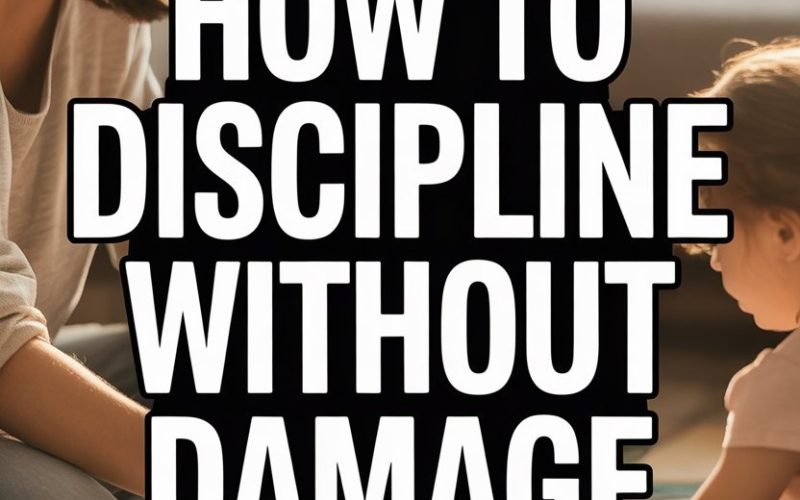Parenting can feel like you’re constantly auditioning for the role of “World’s Least Popular Human.” Sometimes, you’re sure your kids have conspired to test all your limits before breakfast.
But here’s the good news: discipline doesn’t have to be synonymous with shouting, threats, or guilt-inducing time-outs.
It’s entirely possible to teach children self-control and empathy—without scaring the daylights out of them (or yourself).
Let’s take a look at how to set boundaries and guide behaviour in ways that nurture your child’s confidence, strengthen your bond, and leave everyone with their dignity intact.
What Discipline Really Means
Discipline gets a bad rap. Many adults grew up equating the word with punishments, groundings, or the universal horror that was being sent to your room (without Wi-Fi, imagine!).
At its core, discipline actually means “to teach.”
When you shift your mindset from punishment to teaching, everything changes. Now, you’re not so much a drill sergeant as a coach—one who’s there to help your child learn how to manage their feelings and actions.
Connect Before You Correct
Children aren’t tiny robots; they’re small humans with enormous feelings and about as much emotional regulation as a puppy in a postman parade.
When a child is losing the plot, it’s usually because they’re overwhelmed, not evil.
Pausing for connection before correction can work wonders. Drop to their level, look in their eyes, and let them know you see their feelings—even if you don’t love the behaviour. “You’re really upset that your tower fell down, aren’t you?”
A child who feels seen will calm down far faster, making it easier for them to actually hear your guidance.
Experts like Dr. Daniel Siegel (author of “The Whole-Brain Child”) have shown that kids are more likely to cooperate after they feel connected.
It’s not magic. It’s brain science—and it might just save your sanity during the witching hour.
Set Clear, Kind Boundaries
Consistency does not mean rigidity. It’s about making your expectations clear, sticking to them, and delivering consequences that are fair—and fit the crime.
Try to state rules in positive terms. “Shoes stay on feet inside the house,” instead of “Don’t take your shoes off in here!” Kids, like adults, respond better when told what to do rather than what not to do.
When rules are broken, be calm and matter-of-fact. “Oops, you coloured on the wall again. Let’s clean it up together.” This shows you’re not angry—you’re just upholding the boundary.
Natural and Logical Consequences Work Harder Than Yelling
The urge to launch into a dramatic monologue about why scribbling on Nana’s sofa is unacceptable is strong.
But a child’s brain is still under construction; lectures tend to go in one ear and out the other (often before you’ve even finished the first sentence).
Natural consequences let the world do the teaching. If they refuse to wear a raincoat, they get wet. Logical consequences are related directly to the misbehaviour—if they throw their food, mealtime ends early.
Research from the Child Mind Institute supports that consequences tied directly to the action help children learn cause and effect, while endless nagging or shouting just tunes them out.
Pick Your Battles Like a Pro
No one can enforce every rule, every single time.
If you try, you’ll be exhausted, resentful, and probably muttering things under your breath in the pantry. Instead, focus on priorities: safety, respect, and family values.
Is your toddler’s penchant for mismatched socks really worth World War III? Probably not. Save your energy (and your stern voice) for the issues that matter most.
Stay Calm: Easier Said Than Done, But Still Worth Trying
Children are emotional sponges.
When you lose your cool, they soak it right up and reflect it back. When you show self-control (even if it’s through gritted teeth), you’re teaching them the same.
If you need to, take a few deep breaths, splash some water on your face, or mutter affirmations like “This too shall pass” before responding.
You’re not a robot, and nobody expects you to be zen 24/7—but even a moment’s pause can keep a bad situation from spiralling into a full-blown meltdown (yours or theirs).
Use Time-Ins Instead of Time-Outs
Traditional time-outs can leave children feeling isolated or rejected—especially if they don’t understand why they’re being sent away.
Time-ins flip the script: instead of banishing your child, you stay nearby and help them calm down.
This might look like sitting together quietly, giving them a hug if they want one, or just saying, “I’m here with you. When you’re ready, we’ll talk about what happened.”
This approach is backed by experts like Dr. Mona Delahooke, who points out time-ins help children feel secure and learn to regulate themselves, rather than just serving a sentence.
Teach Emotional Literacy, Not Just Obedience
Children who can name their feelings are less likely to act them out in dramatic (and inconvenient) ways. Make feelings part of your family’s daily language.
“You look frustrated. Is that right?” “I see you’re angry that your brother took your toy.”
Books like “The Color Monster” or “How Are You Feeling Today?” can help little ones identify emotions. For older kids, encourage them to talk through problems and brainstorm solutions.
This turns a discipline moment into a mini life lesson.
Apologise When You Mess Up
Every parent loses their patience eventually. Maybe you shouted about spilled milk, or threatened to cancel Christmas (again).
What matters isn’t being perfect—it’s showing your child that adults make mistakes too, and that saying sorry is a sign of strength, not weakness.
A simple, “I was really cross, and I shouldn’t have yelled. I’m sorry. I love you,” can mean the world. It models accountability and repair—and shows your child that relationships can survive even the rockiest moments.
Avoid Shaming and Labeling
Phrases like “naughty boy” or “bad girl” might slip out in the heat of the moment, but they can stick in a child’s mind far longer than you think.
Instead, address the behaviour, not the child. “It’s not okay to hit” lands very differently than “You’re so mean.”
Experts remind us that shame doesn’t teach better behaviour; it just teaches kids to hide their mistakes. Encouragement and gentle correction build confidence and trust.
Use Rewards and Praise Wisely
A sticker chart for every small victory might sound like a good idea until you’re up at midnight cutting out stars.
External rewards can motivate, but research (like this piece from Harvard Graduate School of Education) shows that overdoing it can backfire. Children end up focused on the reward, not the lesson.
Instead, praise effort, kindness, and progress: “I noticed you tried really hard to pack your bag by yourself!” or “Thank you for helping your sister.”
This builds intrinsic motivation—kids want to do the right thing because it feels good, not just because there’s a lollipop in it for them.
The Power of Repair and Reconnection
After a rough patch—whether it’s a screaming match over bedtime or a public tantrum that left you eyeing the nearest exit—it’s tempting to just sweep it all under the rug. But reconnecting is where the magic happens.
Cuddle, share a story, or simply say, “That was tough for both of us. I’m glad we’re together.”
Reconnection reassures your child that love isn’t conditional on perfect behaviour. Family therapist Dr. Becky Kennedy calls this the “most healing parenting tool you have.”
Don’t Go It Alone
Modern parenting can feel lonely.
Every parent needs a lifeline—whether it’s a WhatsApp group, a wise grandparent, or online resources like Parenting Science or Raising Children Network. There’s no shame in asking for ideas or support.
If you’re ever worried about your child’s behaviour or your own reactions, don’t hesitate to talk with a paediatrician or child psychologist. Sometimes, a little professional perspective is all it takes to get back on track.
Gentle Discipline: It’s Not About Being a Pushover
Let’s clear up a common myth. Gentle, respectful discipline is not permissive parenting in disguise. You’re not letting your child run wild or be the boss of everything (though wouldn’t that make for lively family meetings?).
You’re setting limits, holding your ground, but doing so with kindness and empathy. It’s a tougher route in the short term (no quick fixes or magic punishments), but it pays off in the long run.
Research links authoritative, connected parenting styles with higher self-esteem, better emotional regulation, and stronger parent-child relationships.
You’ve Got This—Even on the Sticky Days
Nobody gets it right all the time. Some days, success is everyone making it out the door with pants on the right way round.
Give yourself credit for showing up, setting boundaries, and loving your kids—even when they’re acting like miniature hurricanes.
Discipline without damage is about growing together, learning together, and yes, sometimes apologising together. Your child’s future self (and your future self) will thank you for it.





